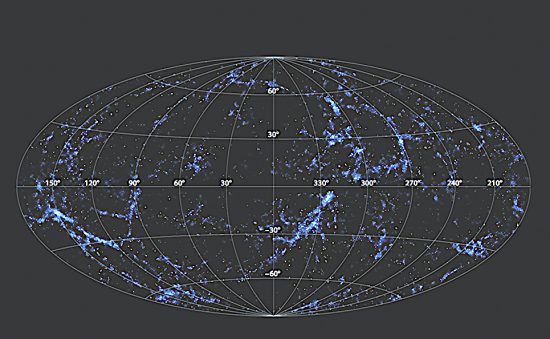
Oct 4, 2019
The Universe is filamentary.
Black holes are said to form when a star with a mass about five times that of the Sun uses-up its fuel. Stars are thought to be internally powered fusion reactors, so it is a push of radiation from inside a star that prevents its collapse under the force of its own gravity.
The standard model of stellar evolution speculates that a star accumulates heavier atomic nuclei in its core, making it impossible to keep outer surface layers away with radiative pressure. Gravity overcomes fusion, so any one star’s gaseous envelope suddenly collapses, rebounding off the core in what astronomers call a “supernova explosion.” Since gravity is no longer hindered by the radiating core, the star is said to shrink under that force, disappearing from normal space, compressing into a mass with no geometry. A ghost of the star’s presence remains as an irresistible gravitational source.
Black holes are a questionable quantity. Despite claims to the contrary, no black hole has ever been observed. What is observed are effects that are more likely to be something other than ultra-dense matter. Rather than matter weighing billions of tons per teaspoon full in order for its effects to manifest, electricity is a more potent force.
In an Electric Universe, gravity gives way to the effects of plasma. The stars are not hot, dense balls of hydrogen. Rather, they are plasma, with fusion taking place on their surfaces and not in their cores. The Electric Universe definition of “plasma” is not the conventional one of “ionized gas.” Plasma is a state of matter: properties such as filamentation, long-range attraction and short-range repulsion, braiding, characteristic velocities, formation and decay of plasmoids, and other phenomena contribute to the plasma condition.
Everything in the Universe is ionized to some degree, therefore it is plasma. Positive ions and negative electrons move through plasma in ways not governed by gravity, although gravity might cause some heavy positive ions to create a charge surplus in one volume of space over another. When that happens, a weak electric field develops.
An electric field initiates electric currents that generate electromagnetic fields. Those fields interact with other fields generated by other currents. In images from space, as well as in high-speed photographs of plasma activity in the laboratory, those currents form twisted pairs of filaments called Birkeland currents. Birkeland currents follow magnetic fields and draw charged material from their surroundings. Electromagnetism “pinches” the dust and plasma into heated blobs of matter called plasmoids. As the electric field intensifies it increases the pinch effect, forming spinning electrical discharges. At first they glow dimly red, then blaze yellow, and finally they might become brilliant ultraviolet arcs, called stars, driven by the electric currents that created them.
Cosmic filaments have structure; each is composed of smaller filaments that scale to an unknown extent. It has been demonstrated that plasma phenomena can scale to fourteen orders of magnitude. Nobel-laureate Hannes Alfvén hypothesized that the scale can go to 28 orders of magnitude or more!
Stars are nodes in electric circuits. Electromagnetic energy could be stored in the equatorial current sheets surrounding them until some trigger event causes them to switch into a polar discharge. The electric jet could receive its energy from a natural particle-accelerator, a “plasma double layer”, with a strong electric field. Toroidal magnetic fields form because of the polar plasma discharge, confining it into a narrow channel. Only electric fields can accelerate charged particles across interstellar space.
Since Birkeland currents are filamentary, and since stars and galaxies occur in strings, the alignment of galactic jets observed by radio astronomers is not due to a “… coherent spin in the structure of this volume of space…”, it is due to the collimated nature of those currents.
Stephen Smith
Hat tip to William Thompson
The Thunderbolts Picture of the Day is generously supported by the Mainwaring Archive Foundation.












